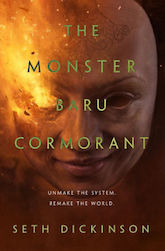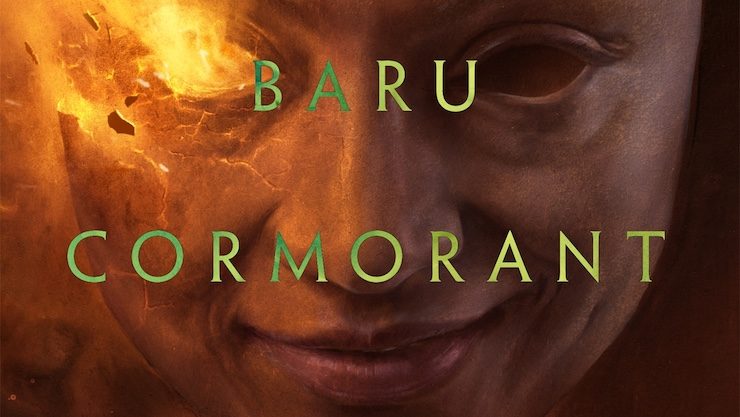Three years on from The Traitor Baru Cormorant, a first novel so clever and subversive that it bore comparison to K. J. Parker’s best and most messed-up efforts, Seth Dickinson is back at last with a book that’s bigger, if not necessarily better, than its imperiously powerful predecessor. Its setting marks a substantial expansion from the several isolated isles explored in these pages before; its dramatis personae takes in a whole new cast of characters in addition to the scant survivors of Dickinson’s devastating debut; and there’s certainly a lot more going on in the story: so much more, as a matter of fact, that the manuscript of The Monster Baru Cormorant had to be cleaved in two. Saying that, size isn’t everything—a sentiment I’m sure The Masquerade’s embattled protagonist would echo if she weren’t so busy bloodily betraying her every belief.
Baru’s betrayals begin from the first chapter of the narrative, when, on the shore of the Elided Keep she now commands, she has her closest confidante chained to a drowning-stone, and watches as the tide takes her. Better this end, she tells herself; better even this dreadful death than the appalling alternative, which is to allow the Falcresti aggressors she ostensibly represents to take Tain Hu as a hostage whose health and welfare would be weighed against Baru’s every bid to “[disembowel] the empire from within.”
It haunts her, this dark deed she’s done. But it also adds fuel to the fire that burns in her breast, and allows her to let go of “the girl who watched Masquerade chanters coming down the reefs of Taranoke, and wondered why her fathers were afraid.” Her sacrifice, and likewise her lover’s, gives Baru license to be a better weapon than “the brilliant furious young woman who accepted the Masquerade’s bargain: join Tain Hu’s rebellion, gather all our enemies together, and betray them to us,” all to surround herself with the promise of power. It allows the Baru of this book to become a so-called “cryptarch” with Agonist as her mantle, and as “a secret lord of the Imperial Throne” she may finally be able to make all of her betrayals mean something. Somehow.
The how of it—how she’ll turn her hard-earned influence back on the Masquerade—is a mystery for us and Baru both for the entire opening act of The Monster, and unless you’ve read or reread The Traitor recently, or spent some time studying this rather excellent refresher, that missing link is likely to turn the first section of the text into a test. Here we have a host of new characters to keep track of, not to mention a few familiar faces, each with motivations and machinations of their own; here’s a huge world in motion from the get-go, positively throbbing with peoples and politics and particulars; here’s a healthy handful of things that have either happened or are happening, all with a presumed role to play in the whole; and here too is Baru, without the slightest clue what to do. “She lived now in a thick fog, and the lights of her hopes seemed very far away.”
To take the long view, much of what Dickinson does in the first third of The Monster is assuredly worth doing. Among other things, his efforts serve to connect The Masquerade’s loosely-placed locations into one lucid landscape whilst providing crucial context for the actions of those individuals whose loyalties are tried in the text. It’s important work, in other words, but Dickinson does it all at once at perhaps the worst possible point in his new novel, frontloading The Monster with the weight of the world when our anchor point is processing the pickle she’s in privately.
It’s only when the Elided Keep has fallen—like all of the territories our apparently appalling protagonist rages through appear destined to—that Baru’s enigmatic handler Cairdine Farrier spells out the significance of what’s to come. He believes that “the next ten years will decide the future of all human life,” that “the course of history will be set [by] the confrontation between Falcrest and the Oriati Mbo, and the choices made as a result.” And that gets Baru thinking: maybe this is how she’ll finally undermine the Masquerade.
She had her opportunity. She could at last point to a single ultimate goal for her work. She would draw Falcrest into war with Oriati Mbo; she would coax and unite and convince the Stakhieczi to invade from the north. And as these two wars destroyed the trade engine that turned in the Ashen Sea, she would secure the absolute annihilation of the Masquerade’s power. The Mask would leave Taranoke. The Mask would leave Aurdwynn.
And if their works were all undone with their departure… if the secrets of inoculation were lost, and the great roads overrun by banditry, and plague left to sweep the world, and babies abandoned in the wind, and the winter given to scurvy, and a portion of the good and great taken each year by a simple tooth abscess… then so be it.
The end. The ruin of everything. A great jet of blood across the face of history. Wasn’t that what she’d promised Tain Hu?
Without her determination to drive the early parts of narrative, without a destination against which we might measure the merits of the journey, The Monster gets off to a deliberate and demanding start, but from this point in the novel on, with the busywork of worldbuilding and whatnot behind him, Dickinson truly lets loose.
A great many pieces of the puzzle come together, ramping up in parallel towards a crushing conclusion that betrays no hint of its origin as the midpoint of the manuscript the author submitted originally. As a character, Baru herself continues to impress, though her development in The Monster is somewhat stunted. By the end, “she’d been taken from her home, sent to a distant province, seduced by a glorious woman, compelled to betray and execute that woman for promotion into a world of betrayal and intrigue,” but much of this is true of Baru at the beginning of the book, too.
Buy the Book


The Monster Baru Cormorant
Markedly more remarkable in terms of their growth over this story’s course are supporting players like Apparitor, Baru’s delightfully disagreeable fellow cryptarch; his seemingly obeisant boy Iraji, who’s keeping a deeply distressing secret; and Tau-Indi of the Oriati Mbo, whose customs and coming of age we’re treated to by way of a few fascinating interludes. There’s even a surprising amount of appropriately elaborate and accordingly rewarding action, which isn’t half bad for the sequel to a novel about the economy.
The Traitor Baru Cormorant was much more than that, of course. It told a sublimely sinister story that I wrote Dickinson was “in complete and total control” of. Here, though I hate to say it, he lets his grip slip a little, but beyond the bumps in the road I’ve been banging on about, it’s back to business as usual—and in these books, business as usual boils down to heart-breaking, brutal, shrewd and often shocking storytelling. A fiendishly clever psychological thriller with sharp speculative edges, The Monster Baru Cormorant is morally abhorrent, yet massively satisfying.
The Monster Baru Cormorant is available from Tor Books.
Niall Alexander is an extra-curricular English teacher who reads and writes about all things weird and wonderful for The Speculative Scotsman, Strange Horizons, and Tor.com. He lives with about a bazillion books, his better half and a certain sleekit wee beastie in the central belt of bonnie Scotland.










